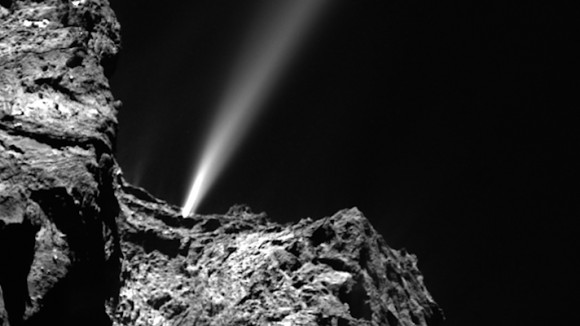| Online: | |
| Visits: | |
| Stories: |

| Story Views | |
| Now: | |
| Last Hour: | |
| Last 24 Hours: | |
| Total: | |
Dramatic Outburst from Comet 67P/Churyumov-Gerasimenko as Approaches the August 13th Perihelion (+Video)
A dramatic short-lived outburst from 67P/Churyumov-Gerasimenko was captured by the OSIRIS narrow-angle camera aboard ESA’s Rosetta orbiter on July 29, 2015.
The most striking result is that the outburst was so intense that it actually managed to push the solar wind away from the nucleus for a few minutes.
Now 67P/Churyumov-Gerasimenko and Rosetta are just one day from perihelion, the point on the comet’s 6.5-year orbit that takes it closest to the Sun.
On 13 August 2015, they will be 186 million km from the Sun, about a third of the distance at rendezvous last August.
The images were taken from a distance of 186 km from the centre of the comet. The jet is estimated to have a minimum speed of 10 m/s and originates from a location on the comet’s neck.
Soon afterwards, the comet pressure sensor of ROSINA detected clear indications of changes in the structure of the coma, while its mass spectrometer recorded changes in the composition of outpouring gases.
Compared to measurements made two days earlier, the amount of carbon dioxide increased by a factor of two, methane by four, and hydrogen sulphide by seven, while the amount of water stayed almost constant.
“This is the brightest jet we’ve seen so far,” comments Carsten Güttler, OSIRIS team member at the Max Planck Institute for Solar System Research in Göttingen, Germany.
“Usually, the jets are quite faint compared to the nucleus and we need to stretch the contrast of the images to make them visible – but this one is brighter than the nucleus.”
Read more here: http://www.esa.int/Our_Activities/Space_Science/Rosetta/Comet_s_firework_display_ahead_of_perihelion
http://www.universetoday.com/121824/dramatic-outburst-at-rosettas-comet-just-days-before-perihelion/

Image credit: ESA http://www.esa.int/Our_Activities/Space_Science/Rosetta/Comet_s_firework_display_ahead_of_perihelion



